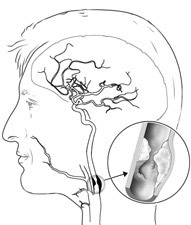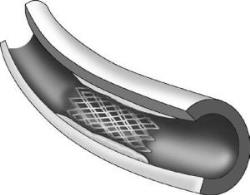What is carotid stenting?
Blockage in the carotid artery There are two carotid arteries (one on each side of the neck) that supply blood to the brain and head. The carotid arteries can be felt on each side of the lower neck, immediately below the angle of the jaw.
Carotid stenting is a procedure used to open up narrowed areas of your carotid arteries to improve blood flow to your brain. It is used to prevent stroke and as treatment for patients who have a stroke.
The procedure is done using a long, thin tube called a catheter. The catheter is inserted into your blood vessel through a small puncture in your groin or arm. It may also be done through a small incision in your neck. This is called transcarotid artery revascularization (TCAR).
This procedure is done by a doctor who specializes in vascular surgery, interventional cardiology or neuroradiology and a team of fellows, nurses and technicians. It is usually done at the same time as a carotid angiography, which is a test to check for narrowed or blocked areas of your carotid arteries.
What happens before I have carotid stenting?
Please follow all instructions from your doctor about eating, drinking and taking medications before the procedure. Your doctor may have you take aspirin, Plavix or other medications before the procedure to reduce your risk of blood clots.
Your healthcare team will help you get ready for the procedure and answer any questions you have.
The procedure is done in an operating room or catheterization lab specially designed for interventional procedures.
If the procedure is done through your groin or arm, the area will be numbed, and you will get medication to make you comfortable and groggy. You will be able to talk to your doctor and other members of the team. If you are having TCAR, you may get this type of sedation or get general anesthesia to put you "to sleep".
What happens during carotid stenting?
You will get heparin or a different blood thinner during the procedure to reduce your risk of a blood clot.
A specially designed catheter and guide wire are placed in the blood vessel past the narrowed area in your carotid artery. The catheter may stop or reverse blood flow to your brain. A filter is used to act like a fishing net and catch any debris that comes loose during the procedure. This protects your brain.

Your doctor uses X-ray to guide a small balloon catheter to the blockage. The balloon is inflated, which causes the plaque or blockage to press against the artery wall. This opens up the artery to let more blood flow through it. The balloon is removed and a small, metal mesh tube called a stent is put inside the artery. The stent stays in place permanently and acts as a scaffold to support the artery and keep it open. After several weeks, the artery heals around the stent.
After the stent is in place, your doctor will take pictures or use an angiogram to make sure the narrowing or blockage is fixed. Once this is confirmed, blood flow to your brain is restored and the filter is removed.
Your doctor may then use a special device to repair the area used for the procedure. Or, pressure may be applied to the area after the blood thinners have worn off.
How long does the procedure last?
The procedure usually lasts about 2 hours, but the preparation and recovery time add several hours.
What happens after the procedure?
In the Hospital
You will spend the night in the hospital after your procedure. A team of specially trained doctors and nurses will keep a close eye on your blood pressure and watch for any problems.
If the sheath is left in place after the procedure, it will be removed in the recovery room after the blood thinners have worn off. After the sheath is removed, you will lie flat without bending your legs — usually 2 to 4 hours. This is to prevent bleeding. We will give you medication to help you stay comfortable.
You will not be able to eat for a few hours after the procedure. You will be able to have clear liquids.
Before you go home, you will have an exam and your doctor will talk to you about the results of the procedure. You will get an ultrasound of your carotid artery either before you go home or when you come into the office.
You will also get discharge instructions. Please read this information carefully. It contains details about activity restrictions, medications, diet and when to call your doctor.
After you go home
Medications: You will need to take medication to reduce your risk of blood clots after your procedure. These medications are important because blood clots after a carotid stent procedure can cause a stroke. You will get details about all the medications you need to take. Please ask your doctor or pharmacist if you have any questions about your medications. Do not stop taking your medications without talking to your doctor.
Blood pressure: Before you leave the hospital, your nurse will show you how to take your blood pressure. You will need to keep track of your blood pressure at home. Your doctor or nurse will let you know how often to do this.
Managing your health: Carotid stenting restores blood flow to your brain and reduces your risk of a stroke, but it does not cure carotid disease. It is important to follow a healthy lifestyle that includes not using tobacco products, following a healthy diet, regular exercise after your doctor says it is OK after your procedure, taking all medications as prescribed and managing other chronic health conditions.
What are the risks of the procedure?
Your doctor will talk to you about the specific risks and benefits of carotid stenting. Risks are based on how bad your carotid disease is, where your blockage is, whether you’ve had a stroke and other medical conditions you have.
Some of the possible risks include:
- Allergic reaction to the medication or contrast material used during the procedure.
- Irregular heart rhythm.
- Bleeding at the catheter insertion site.
- Stroke or death.
Please share your questions and concerns with your doctor.
What is restenosis?
Restenosis means that the section of your artery that was opened is blocked or narrowed again. It is caused by the buildup of scar tissue in the section of artery that has the stent.
The risk of restenosis is highest 6 to 12 months after your procedure. It is important to keep all follow-up appointments so your doctor can check for problems.
You will need to have an ultrasound every 6 to 12 months to check the stent.
If you have symptoms similar to what you experienced before the procedure, call your doctor right away.